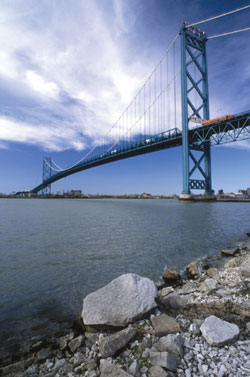
Bridging the border
The Ambassador Bridge |
|
The stately Ambassador Bridge linking Windsor and Detroit is a powerful symbol of the geographic and economic ties between Canada and the U.S. Photo: courtesy of The Ambassador Bridge |
They rumble night and day down Ontario's Highway 401, trucks loaded with Canadian goods headed for markets in the United States and beyond. Their next stop: the stately Ambassador Bridge, the world's longest international suspension bridge. Linking Windsor and Detroit, it hums with vehicles, an average of 9,500 trucks crossing both ways every day of the year, carrying more merchandise than passes through any other border crossing on the globe.
With 45,000 trucks traversing the entire border daily - that's one every two seconds - the span vividly symbolizes the geographic and economic ties that have made Canada and the U.S. each other's most important trading partner. If the border were not to function well, neither would the trading relationship.
Efficient border management is crucial not only to the economies of Canada and the U.S., but to their security as well. With this in mind, in the aftermath of the events of September 11, 2001, Canada and the U.S. signed the Smart Border Declaration. Accompanied by a 32-point Action Plan that covers everything from port inspections to joint law enforcement teams, the accord aims to ensure a smoothly operating border that keeps cargo flowing while addressing security concerns.
"The issue is risk management," says George Costaris, manager of political-economic relations and public affairs at the Canadian Consulate in Detroit. "The goal is to ensure that the border functions well without sacrificing either trade or security."
One of the most welcome developments is expedited clearance for preauthorized shipments, known as FAST. David Bradley, Chief Executive Officer of the Canadian Trucking Alliance, a federation of provincial trucking organizations, says dedicated FAST lanes for truck shipments are "the single best hope we have for a border that runs smoothly."
In addition, under the NEXUS program, preapproved, low-risk travellers may use dedicated lanes at about a dozen bridge and land crossings. The latest innovation for travellers is NEXUS Air, now being piloted at Vancouver International Airport. After posing before a digital camera that uses iris recognition technology to verify their identity, preapproved NEXUS "members" can complete the U.S. customs and immigration process at a self-service kiosk. Canadians re-entering the country may use the self-service kiosk to declare goods and pay duties or taxes.
Underlining its commitment to the Action Plan, the Government of Canada has established a $600-million Border Infrastructure Fund for areas such as new highway approaches and improved facilities, focusing on the busiest crossing points between Canada and the U.S.
Another key initiative of the plan is the expansion of the Integrated Border Enforcement Teams to every strategic location across the Canada-U.S. border. These multi-agency and binational law enforcement teams increase the ability to pursue groups and individuals suspected of criminal and terrorist activities while allowing unfettered cross-border access by lawful citizens.
Bradley describes border concerns as one of Canada's most pressing economic issues, and few would disagree. For both the Canadian and U.S. governments, as well as for importers and exporters, business travellers and day-trippers, the Smart Border is the key to keeping the 130 border crossings operating effectively.
So significant is the accord that it was among the top agenda items when Prime Minister Paul Martin and U.S. President George W. Bush met in Ottawa in November. "We will collaborate further to ensure that our shared border is closed to terror but open to the safe movement of people and goods," Mr. Martin said.
The two leaders discussed the possibility of a new crossing at the Windsor-Detroit point, an acknowledgement of the critical role played by border links in generating jobs and prosperity for the continent's two northern neighbours.
For more information on the Canada Border Services Agency visit www.cbsa-asfc.gc.ca.
To learn about the Border Infrastructure Fund see www.infrastructure.gc.ca and click on "Infrastructure Programs."
Published on: 2005-03-10 (9676 reads)
Recent Reviews
- War Horse 2012-01-02
- Legion 2010-01-23
- Zombieland 2009-10-02
- The Martyr's Oath: The Apprenticeship of a Homegrown Terrorist 2009-08-20
- Bachman Cummings 2009-06-22
- Star Trek 2009-05-03
- X-Me Origins: Wolverine 2009-05-01
- Soloist 2009-04-24
Latest Topics in Canadian Forums
- British Columbia to recriminalize use of drugs in public spa
[Current Events] Last post by Scape - What The Hell, Canada?
[Canadian Politics] Last post by Scape


